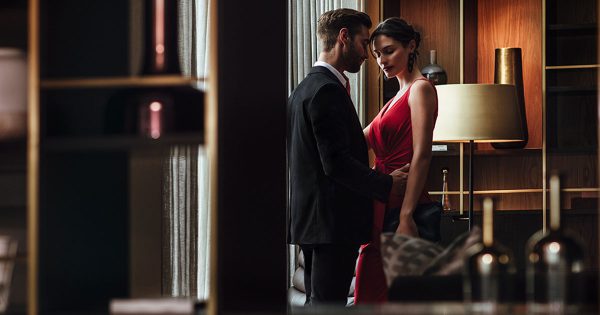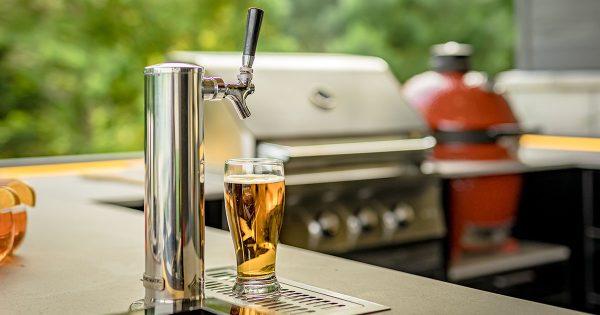The Champagne, How to Appreciate It
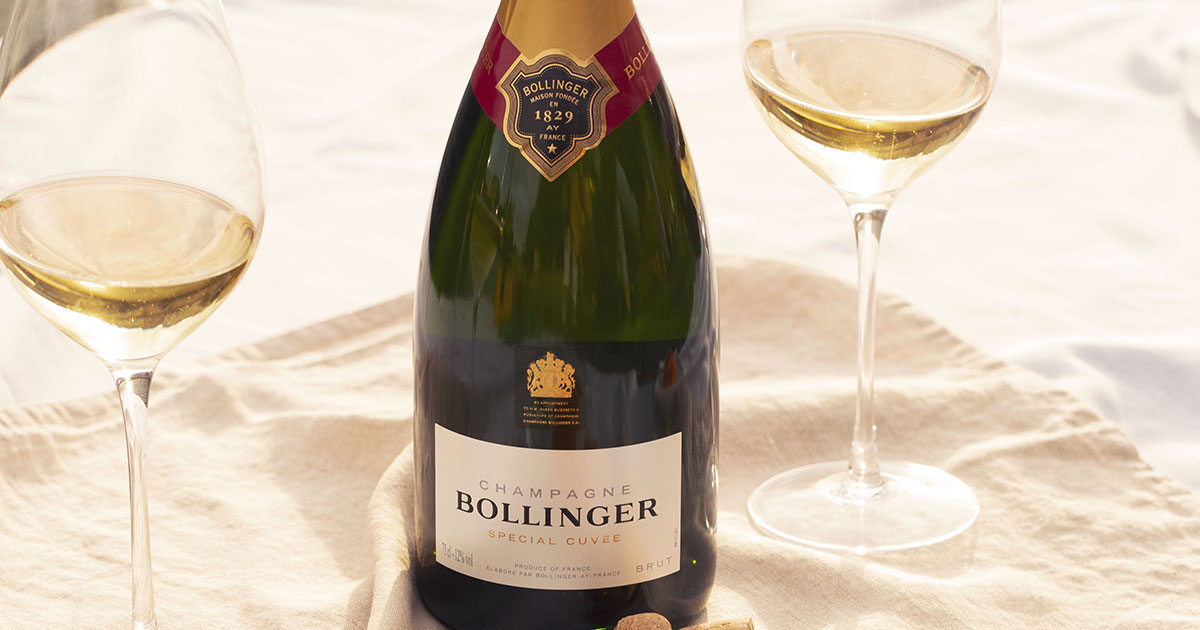
The Champagne is an essential part of the art of various taste pleasures. You have to know how to taste it. Speaking of refinement, if there is one champagne that’s very masculine, James Bond’s, Bollinger, of which an edition has recently been released. Moreover, you will find more details on the latter in addition to this article. These products are offered at the SAQ and the LCBO.
Let’s start with the different types of champagne, because yes, there are several. Brut champagne, containing less than 12 g of sugar per litre, are among the most popular products on the market. The Extra Dry between 12 g and 17 g / L, the Sec (Dry in English) ones between 17 g and 32 g / L, the Demi-sec ones between 32 g and 50 g / L, and finally the Doux, with more than 50 g of sugar per litre.
We will remember that dry champagne (often called sec) is sweeter than a brut! For the Bollinger Cuvée Special, it is 8.1 g/L, so it is not at all sweet on the palate; it is really a delight. The vintage brut champagne, is made from grapes of a single year. It is rare for sparkling wines and champagnes to be vintage. It is only in exceptional years that we can see champagne made from the same grapes, such as La Grande Année 2004 and 2012 at Bollinger, for example; otherwise, it is a blend of years that you will find in the bottle.
There is a trend among purists: the desire to dose all types of champagne very little. Whether they are extra-brut (between 0 g and 6 g/L), non-dosed, plain brut or zero dosage (less than 3 g/L), they would express more the wine character according to those who adore them.
The champagne: Blanc de Blancs or Blanc de Noirs ?
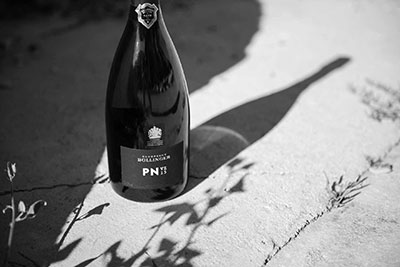
Credit: Bollinger
In Champagne, Blanc de Blancs is used to designate champagne made exclusively from white Chardonnay grapes. The Blanc de Noirs is a white Champagne wine made from black grapes with white juice such as Pinot Noir and Pinot Meunier. Visually, the latter will be slightly more golden than a Blanc de Blancs champagne where the colour is a golden-green hue.
In terms of bubbles, it is much the same. As for the aromas, the Chardonnay develops, for its part, airy notes of white flowers (acacia, elderflower) while the Pinot is characterized by its headier yellow fruit and floral scents such as peony or rose. With Chardonnay, we will have champagne that gives freshness, more lemony, while Pinot gives a richness to champagne, warmer in the mouth.
The champagne: different bottle size.
As we celebrate less as a group, this will certainly resume very soon. Here is a small lexicon of the different bottle sizes.
- Quarter: 200 ml
- The half-bottle or girl: 375 ml
The most famous and best-selling bottles
- The standard or Champenoise bottle: 750 ml
- The Magnum: 1.5 L (2 bottles of champagne)
- The Jeroboam: 3 L (4 bottles of champagne)
Large capacity bottles
We love to see them, but some are rarer and other grandiose! Some are made on demand for major events.
- The Methuselah: 6 L (8 bottles of champagne)
- The Salmanazar: 9 L (12 bottles of champagne)
- The Balthazar: 12 L (16 bottles of champagne)
- Nebuchadnezzar: 15 L (20 bottles of champagne
- The Salomon: 18 L (24 bottles of champagne)
- The Sovereign: 26,25 L (35 bottles of champagne)
- The Primate: 27 L (36 bottles of champagne
- The Melchisédech: 30 L (40 bottles of champagne)
How to drink the champagne?
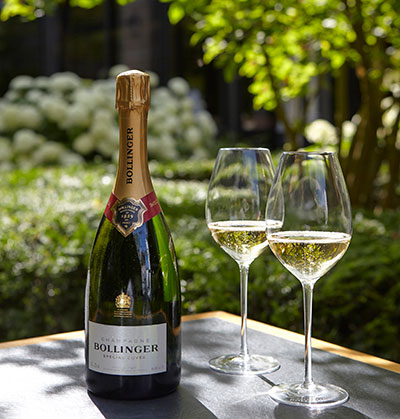
Credit: Bollinger
The champagne: Before service
Champagne should never be sent to the freezer. It is important to refrigerate it about 6 hours before consumption or immerse it in a mixture of water and ice until it reaches serving temperature. However, never serve it over ice; it is a bit like shattering champagne bubbles’ refinement. It is advisable to serve each of Bollinger’s cuvées at 10° or even 12°, like the most prestigious white wines.
The champagne: The Service
There are a few rules to follow when tasting champagne. First, you have to respect the aromatic structure of champagne, or in other words, it adapts to the dish and not the other way around. Second, the aromatic nuances must complement or oppose the dishes on the table.
Wine Glass or Flute?
In recent years, the champagne glass has taken over the flute. The small cup had its heyday several years ago, but the glass serves the tasting much better. Besides, Lehmann makes magnificent ones. Furthermore, do not forget to hold the latter by the stem or the foot so as not to heat the precious liquid. We have a rebate at Alambika, look at the end of M. Boileau’s feature.
Are you hesitating in front of the shelves? Always choose a brut. You will rarely be disappointed. Moreover, it is not necessarily the highest price that makes the best champagne. Here are some choices in the Bollinger range, the most gentlemanly of champagne.
The Bollinger House and Royalty

Founded in 1829, Champagne Bollinger is one of the few remaining family-owned champagne houses still operating today. With its distinctive line of Pinot Noir champagne, the house has enjoyed a close association with Great Britain since 1858 and prides itself on having held a royal mandate without interruption since its first grant by Queen Victoria in 1884.
The Royal Warrants Holder Association was established in 1840. Its main objective is to ensure the Royal Mandate’s continued existence as a valuable and respected institution.
The Association is not part of the Royal Household but belongs to its members. She advises members on all matters relating to their Royal Mandates and helps them correctly interpret and implement the Lord Chamberlain’s rules, which govern the Royal Mandate.
For this purpose, Bollinger was served at the wedding of the late Lady Diana and Prince Charles. As we said earlier, it is the favourite of famous British spy James Bond.
The champagne Cuvées
Bollinger Special Cuvée (available in several formats)
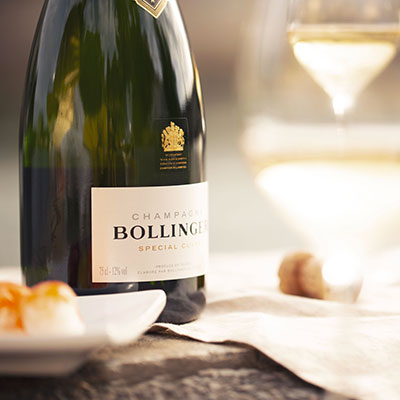
Credit: Bollinger
Bollinger’s entry-level, and also its flagship product, the Bollinger Special Cuvée. Made from 60% Pinot Noir, 25% Chardonnay and 15% Meunier, over 85% of it is made up of Grands and Premiers Crus. Its maturation time in the cellar is more than twice the appellation rules. We have a moderate Brut for its dosage, 8 to 9 grams per litre of sugar depending on the years.
For its pairings, it is perfect with every fish, in particular sushi and sashimi, as well as crustaceans such as shrimp, langoustines, lobster or grilled lobster. It will be appreciated with poultry and white meats, Parmesan and large cured hams.
To highlight its unique style, bouquet and aromas, the people at Bollinger advise us to serve the Special Cuvée between 10 and 12° C. Enjoy it now or choose to let it age in the cellar.
Bollinger Rosé (750 ml)
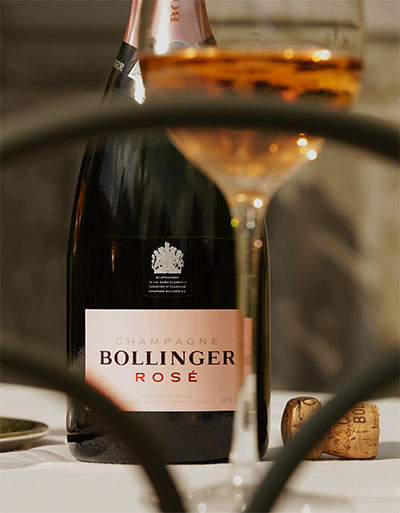
Credit: Bollinger
You may know, but at Bollinger, they also make superb red wines, some of which are offered in SAQ’s, such as the one from the legendary Côte aux Enfants, in Aÿ. Since the creation of Bollinger Rosé in 2008, the Poirier Saint-Pierre and Montboeuf plots, in Verzenay, have been worked in the same way as the Côte aux Enfants to complete the production. Because only great wines can make great champagne.
It’ Bollinger’s entry-level rosé. Made from 62% Pinot Noir, 24% Chardonnay, 14% Meunier and added 5 to 6% red wine only to give it its magnificent colour, it is composed of more than 85% of Grands and Premiers Crus. Its maturation time in the cellar is more than twice the appellation rules. It’s a moderate Brut for its dosage, either 7 to 8 grams of sugar per litre depending on the years, or a little less than the Special Cuvée.
As for pairings, rosé also loves fish such as langoustines, lobster or salmon on one side. You will enjoy tasting it with slightly spicy Asian cuisine, like chef Antonio Park for example. It is a delight with fruit-based desserts such as blueberry soup, a strawberry pie or a raspberry.
Bollinger Rosé marks an intimate and quirky moment, say the professionals of the famous champagne brand; so why not the Bollinger afternoon tea? It is also perfect for a picnic as an aperitif or with a dessert on the fruit and not very sweet. To enhance its unique style, bouquet, and aroma, it is advisable to serve Bollinger Rosé between 10 and 12° C. To be enjoyed now!
Bollinger La Grande Année 2007 (Several sizes)
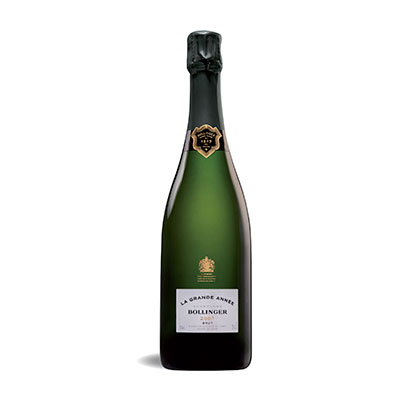
Credit: Bollinger
For this vintage brut, we find an elaboration of 70% Pinot Noir, 30% Chardonnay. These 14 wines come mainly from Aÿ and Verzenay for the Pinot Noir and Cramant and Oger for the Chardonnay. Its composition is over 91% Grands Crus and 9% Premiers Crus for the exclusive use of the cuvée. Its fermentation is carried out entirely in barrels. Note that only the very high-quality harvests are vintage at Bollinger, the very early harvest and the great freshness of this vintage place 2007 under the sign of exception.
Its maturation time in the cellar is more than twice the appellation rules, and the latter is done under a cork stopper. For its dosage, we have a low Brut, i.e., 7 grams of sugar per litre.
You will love it with foie gras, fresh or pan-fried, like Rougié, for example, made in Quebec. You will dare the grilled fish, or in sauce and lobster. We will go one step further with the roast lamb or veal and at the end of the meal with the Parmesan or the Comté.
According to the Bollinger experts, La Grande Année 2007 is the must-have champagne for gastronomy and fine hotels. It is the ultimate meal champagne. To highlight its unique style, bouquet and aromas, they advise you to serve it between 8 and 10° C. Enjoy it now or choose to let it age in the cellar.
Bollinger La Grande Année Rosé 2007 (750 ml)
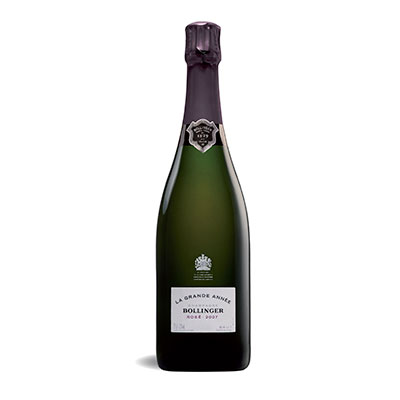
Credit: Bollinger
A rosé from Bollinger, yes, but this is an extraordinary rosé: it was Mrs Bollinger’s choice. Thus was born La Grande Année Rosé. A unique encounter of vintage champagne of excellence and red wine from a unique plot, the legendary Côte aux Enfants (offered in SAQ as we told you above). In Champagne, producing such quality red wine is a challenge, a rarity in the purest Bollinger style.
For this vintage brut, we find an elaboration of 72% Pinot Noir and 28% Chardonnay. These 14 wines come mainly from Aÿ and Verzenay for the Pinot Noir and Cramant and Oger for the Chardonnay. Its composition is 92% Grands Crus and 8% Premiers Crus. In this calculation, 6% red wine from the Côte aux Enfants is used exclusively for the cuvée. Its fermentation is carried out entirely in barrels. Note that only the very high-quality harvests are vintage at Bollinger; the very early harvest and the great freshness of this vintage place 2007 under the sign of the exception and reveal a champagne in which is particularly expressed the brilliance or the fruit.
Its maturation time in the cellar is more than twice the appellation rules, and the latter is done under a cork stopper. For its dosage, we have a low Brut, i.e., 7 grams of sugar per litre.
Here in the pairings, the professionals of Bollinger dare. They recommend duck breast (Rougié makes an excellent one), quail, pigeon or guinea fowl. For the wild meat, a deer with hunter sauce will be perfect. Like its little brother Rosé, it goes wonderfully with exotic or oriental cuisine. Try a rhubarb and berry crumble for dessert.
La Grande Année Rosé 2007, like its, alter ego of 2007, sublimates the most cutting-edge gastronomic moments for perfectly accomplished pairings. Powerful and great complexity can be enjoyed during one-to-one dinners for endless moments of seduction. To highlight its unique style, bouquet and aromas, Bollinger advises you to serve it between 8 and 10° C. Enjoy it now or choose to let it age in the cellar.
Bollinger La Grande Année 2008 (750 ml)
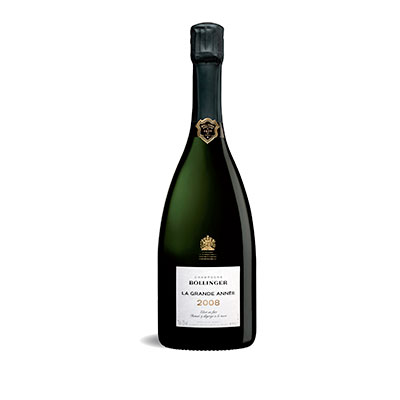
Credit: Bollinger
La Grande Année 2008 is the embodiment of craftsmanship that has always been preserved by Maison Bollinger. The wine is thus exclusively vinified in small old oak barrels. Champagne Bollinger has never abandoned this ancient method, which promotes the development of aromas of great finesse. After prolonged ageing on the lees, each bottle of La Grande Anne is still stirred and disgorged by hand today.
We find an elaboration of 71% Pinot Noir, 29% and Chardonnay for this vintage brut. These 18 crus come mainly from Aÿ and Verzenay for the Pinot Noir and Cramant and Le Mesnil-sur-Oger and Cramant for the Chardonnay and are used exclusively for the cuvée.
The fermentation of this great wine is carried out entirely in barrels, and only the very high-quality harvests are vintage at Bollinger. In 2008, the grapes’ remarkable maturity, combined with exceptional acidity, gave birth to a wine of infinite depth and allowed the creation of an exceptional cuvée.
It matures under a cork stopper for a time in the cellar more than twice as long as the appellation rules.
Here, in the pairings, Bollinger’s professionals advise us the cured black pork ham or the Noix de Saint-Jacques (a mollusk similar to scallop) as an aperitif, as a tartare or with the classic grilled lobster. A chicken in a light creamy sauce would also be perfect.
Like the Grandes Années collection, The Grande Année 2008 is also a true champagne for gastronomy. To highlight its unique style and aromas, the Bollinger sommeliers advise us to serve this wine between 8 and 10° C. Enjoy it now or choose to let it age in the cellar.
Bollinger PN VZ15 (750 ml)
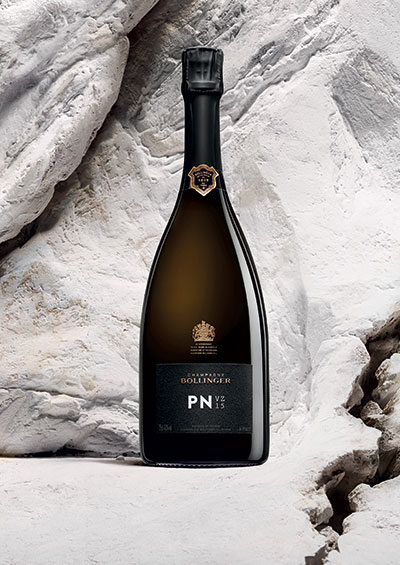
Credit: Bollinger
As you may have read throughout the last few lines, Pinot Noir is one of the Bollinger style pillars, and the House has built its reputation by magnifying this grape. The PN cuvée, which reflects this name, the first edition of which will see the light of day in 2020, results from research around the latter’s taste and its different origins in Champagne. This nectar helps extend this heritage and assert the legendary style of Bollinger while reinventing itself each year and is now in the SAQ’s.
Obviously, it is 100% Pinot Noir from 2015 (Blanc de Noirs) at the base. The main cru is from Verzenay, hence the VZ, associated with other villages (Aÿ, Bouzy and Tarifières), and it was made using this cuvée exclusively. The maturation time in the cellar is more than twice as long as the appellation rules like the majority of Bollinger products. We will find a moderate dosage of 7 grams of sugar per litre.
For the pairings, we will opt for a thin tomato tartlet, rosés de Champagne risotto-style lentils, delicious sweetbreads and chestnuts or a Langres cheese, which is a cheese intense in taste and smell. It can be purchased in certain specialty cheese boutiques in Montreal. I want to thank Maxime Delmont, chef de cuisine at Fairmont The Queen Elizabeth, to clarify the Langres term.
Here is a wine to share between enthusiasts in search of the different expressions of Pinot Noir in Champagne. To highlight its unique style and its aromas, Bollinger recommends that you serve it between 8 and 10° C. Enjoy now or choose to let it develop in the cellar.
This VZ15 edition is the first interpretation. Bollinger says it will be followed by news that will continue to explore the House’s different terroirs.
“This cuvée made entirely from Pinot Noir is ingrained in what has become the very essence, the DNA of our House—an inimitable vision of an iconic grape variety and uncompromising efforts to fulfil the mission we started in 1829 as creators of taste.”
Charles-Armand de Belenet,
Chief Executive Officer of Champagne Bollinger about the PN VZ15 2020
Other Bollinger Cuvées
Besides, we find at Bollinger, and sometimes in SAQ, the Récemment Dégorgé, or R.D., which is a particularity of the House. It is a Great Year that ages longer in the cellar (8 to 25 years) with a late disgorgement (the latter’s date is indicated on the label).
Also offered, the Vieilles Vignes Françaises is the tribute that the Maison Bollinger pays to the Champagne region’s wine. Bollinger preserves the few free-standing plots that have resisted phylloxera (an insect that attacks vines). These vines are cultivated in crowds and worked manually. Exclusively vintage, composed only of Pinot Noir, Vieilles Vignes Françaises presents Champagne wine’s taste as it was in the 19th century.
La Grande Année 2012, named in the Top 10 of Wine Spectator, will soon arrive in SAQ.
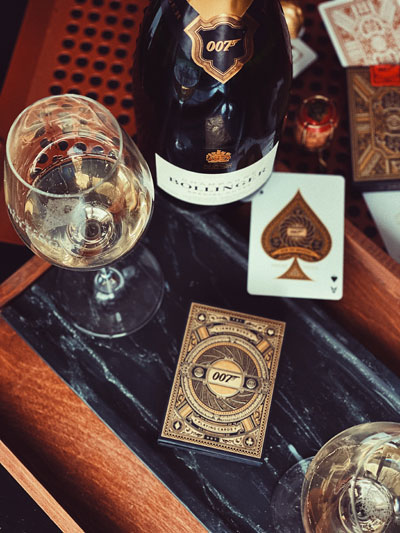
Photographs: Normand Boulanger | Gentologie
Discover the Bollinger Spécial Cuvée Edition 007
The Bollinger champagnes in SAQ
The Bollinger champagnes in LCBO
Article originally published in the Gentologie Magazine Issue 6
*Thanks to the Sélections OENO team for providing us a bottle of Bollinger Special Cuvée 007



